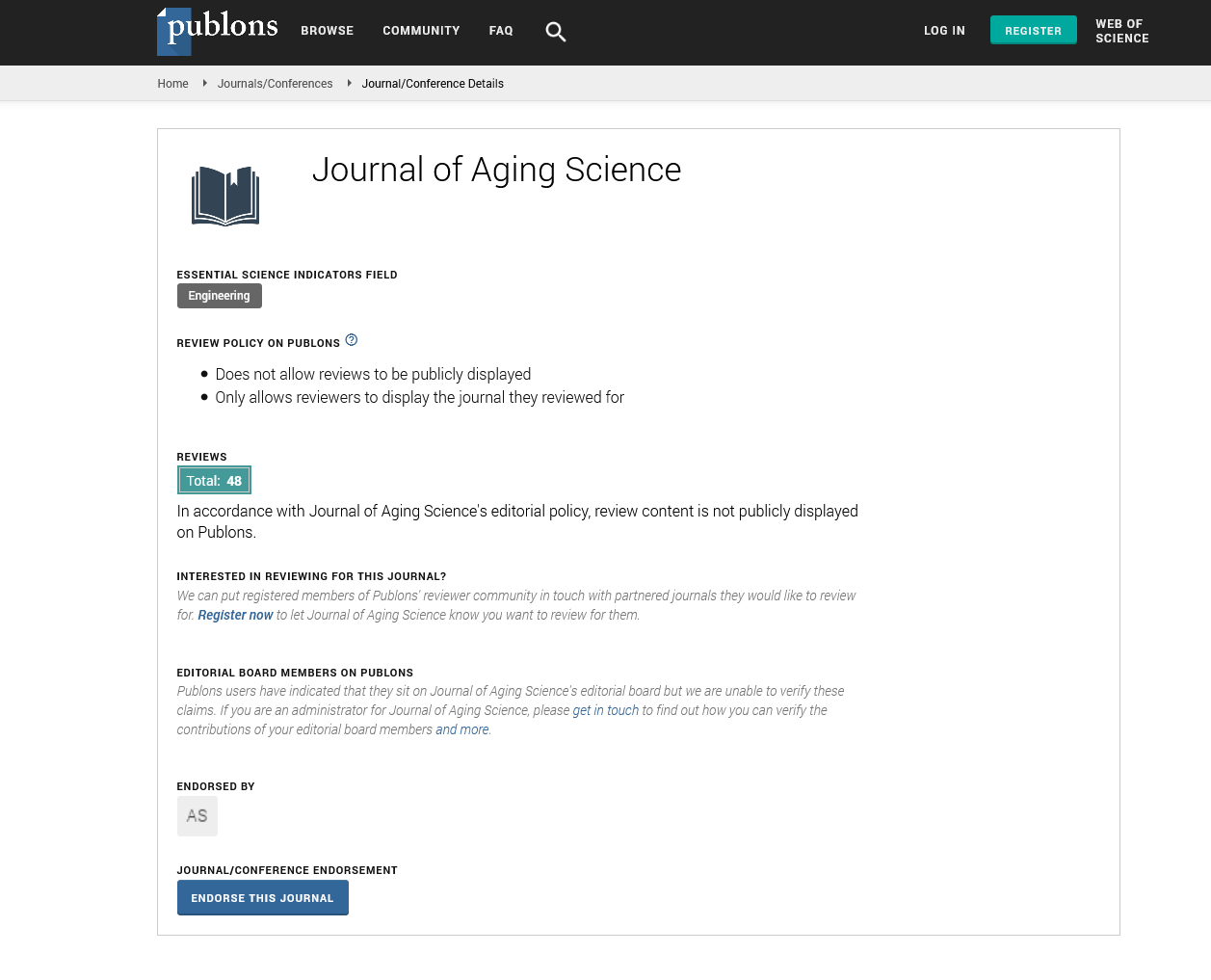Indexed In
- Open J Gate
- Academic Keys
- JournalTOCs
- ResearchBible
- RefSeek
- Hamdard University
- EBSCO A-Z
- OCLC- WorldCat
- Publons
- Geneva Foundation for Medical Education and Research
- Euro Pub
- Google Scholar
Useful Links
Share This Page
Journal Flyer

Open Access Journals
- Agri and Aquaculture
- Biochemistry
- Bioinformatics & Systems Biology
- Business & Management
- Chemistry
- Clinical Sciences
- Engineering
- Food & Nutrition
- General Science
- Genetics & Molecular Biology
- Immunology & Microbiology
- Medical Sciences
- Neuroscience & Psychology
- Nursing & Health Care
- Pharmaceutical Sciences
Commentary - (2024) Volume 12, Issue 4
Neurodegeneration and Cognitive Decline: Advances in Understanding Aging Brain Dynamics
Yu Zhang*Received: 27-Nov-2024, Manuscript No. JASC-24-27784; Editor assigned: 29-Nov-2024, Pre QC No. JASC-24-27784 (PQ); Reviewed: 13-Dec-2024, QC No. JASC-24-27784; Revised: 20-Dec-2024, Manuscript No. JASC-24-27784 (R); Published: 26-Dec-2024, DOI: 10.35248/2329-8847.24.12.393
Description
The aging brain is a complex organ undergoing multifaceted changes that affect its structure, function and overall health. Neurodegeneration and cognitive decline are key challenges associated associated with aging, manifesting as a spectrum ranging from normal age-related cognitive changes to severe impairments like dementia. Advances in neuroscience, molecular biology and imaging technologies have provided deeper insights into the effectives of the aging brain, paving the way for novel interventions and strategies to preserve cognitive health.
The aging brain: An overview
Aging is associated with structural and functional changes in the brain, including reductions in brain volume, neuronal loss and alterations in synaptic connectivity. The prefrontal cortex, hippocampus and cerebellum are particularly vulnerable to age related changes. While these changes are part of normal aging, they can also set the stage for neurodegenerative diseases.
One of the primary markers of an aging brain is the gradual decline in cognitive functions, such as memory, attention and problem-solving. However, not all cognitive changes are pathological. Mild forgetfulness or slower processing speeds are considered normal aspects of aging. The challenge lies in distinguishing between normal aging and early signs of neurodegenerative diseases like Alzheimer’s and Parkinson’s.
Neurodegeneration: Mechanisms and key players
Neurodegeneration involves the progressive loss of structure and function in neurons. It is central to many age-related cognitive disorders, including Alzheimer’s Disease (AD), Parkinson’s Disease (PD) and frontotemporal dementia. Although these conditions differ in their clinical presentations, they share overlapping pathological mechanisms, such as the accumulation of abnormal proteins, mitochondrial dysfunction, oxidative stress and neuroinflammation.
Protein misfolding and aggregation: Proteinopathies are a defining feature of many neurodegenerative diseases. In Alzheimer’s disease, the accumulation of beta-amyloid plaques and tau tangles disrupts neuronal communication and triggers cell death. Similarly, Parkinson’s disease is characterized by the aggregation of alpha-synuclein into Lewy bodies. These protein aggregates interfere with normal cellular functions, leading to progressive neuronal damage.
Mitochondrial dysfunction: Mitochondria, the powerhouses of the cell, are necessity for maintaining neuronal health. With age, mitochondrial function declines, resulting in reduced energy production and increased production of Reactive Oxygen Species (ROS). The brain, being metabolically active, is particularly susceptible to oxidative stress, which damages cellular components and accelerates neurodegeneration.
Neuroinflammation: Chronic inflammation in the brain has emerged as a key contributor to neurodegenerative diseases. Microglia, the brain’s resident immune cells, become overactive with age and release pro-inflammatory cytokines. While shortterm inflammation can be protective, chronic neuroinflammation increass neuronal damage and promotes disease progression.
Synaptic dysfunction and loss: Synapses are critical for communication between neurons and are necessity for learning and memory. Age-related changes in synaptic structure and function impair neural plasticity, a fundamental of cognitive processes. In diseases like Alzheimer’s, synaptic loss correlates strongly with cognitive decline, even more than neuronal loss.
Cognitive decline: Spectrum and risk factors
Cognitive decline in aging spans a spectrum from Mild Cognitive Impairment (MCI) to severe dementia. MCI is an intermediate stage where cognitive changes exceed normal aging but do not significantly impair daily life. While not all cases of MCI progress to dementia, it is a significant risk factor.
Several factors influence the trajectory of cognitive decline, including genetics, lifestyle and comorbid conditions. The APOE ε4 allele, for example, is a well-established genetic risk factor for Alzheimer’s disease. Conversely, lifestyle factors such as physical activity, a healthy diet and mental stimulation are associated with reduced risk of cognitive decline. Conditions like hypertension, diabetes and obesity also increase age-related cognitive decline by compromising cerebrovascular health.
Advances in understanding aging brain dynamics
Recent technological and scientific advancements have revolutionized our understanding of the aging brain. Imaging techniques, such as Magnetic Resonance Imaging (MRI) and Positron Emission Tomography (PET), have enabled researchers to visualize structural and functional changes in the brain over time. These tools have been instrumental in identifying biomarkers for early diagnosis of neurodegenerative diseases.
Biomarkers and early detection: Biomarkers have become pivotal in understanding the progression of neurodegenerative diseases. For example, Cerebrospinal Fluid (CSF) levels of betaamyloid and tau proteins are used to diagnose Alzheimer’s disease. Blood-based biomarkers are also emerging, offering less invasive and more accessible options for early detection.
Genomics and precision medicine: Advances in genomics have clarify on the genetic basis of neurodegenerative diseases. Whole-genome sequencing and transcriptomics have identified risk genes and pathways involved in brain aging. These discoveries are driving the development of targeted therapies aimed at modifying disease pathways.
Neuroprotection and regeneration: Understanding mechanisms of neuroprotection and regeneration has opened new therapeutic methods. Stem cell research and neurogenesis studies have revealed the brain’s capacity to regenerate under certain conditions. Pharmacological agents targeting neuroinflammation, oxidative stress and protein aggregation are being actively explored.
Future directions and challenges
Despite significant advances, several challenges remain in addressing neurodegeneration and cognitive decline. One major hurdle is the heterogeneity of aging processes and neurodegenerative diseases, which complicates diagnosis and treatment. Additionally, translating findings from basic research into effective clinical interventions remains a slow process.
Future research is likely to focus on the exchange between genetic, environmental and lifestyle factors in brain aging. Understanding individual variability will enable personalized approaches to prevention and treatment. Furthermore, integrating artificial intelligence and machine learning into neuroscience holds potential for uncovering complex patterns in brain aging data.
Conclusion
Neurodegeneration and cognitive decline are significant concerns in the context of an aging population. Advances in understanding the effectives of the aging brain have provided a wealth of knowledge about the underlying mechanisms and potential interventions. By using these insights, we can work towards preserving cognitive health and improving the quality of life for aging individuals. A multidisciplinary approach surrounding biology, medicine, technology and public health will be necessity in meeting the challenges of brain aging in the years to come.
Citation: Zhang Y (2024). Neurodegeneration and Cognitive Decline: Advances in Understanding Aging Brain Dynamics. J Aging Sci. 12:393.
Copyright: © 2024 Zhang Y. This is an open-access article distributed under the terms of the Creative Commons Attribution License, which permits unrestricted use, distribution and reproduction in any medium, provided the original author and source are credited.

